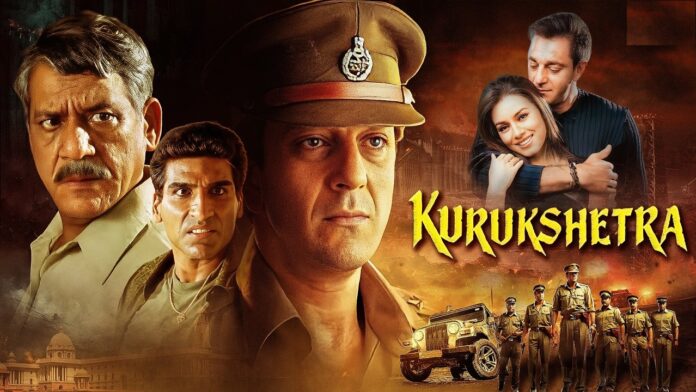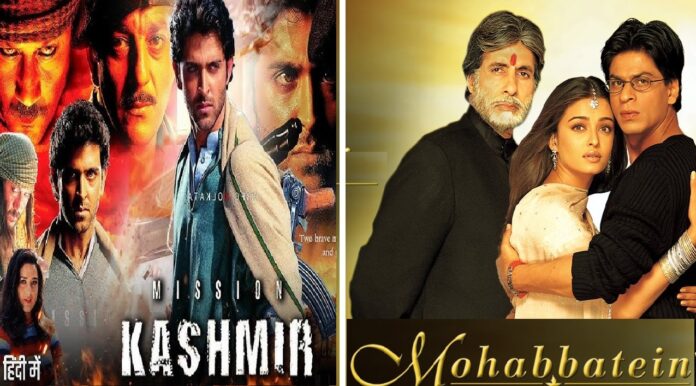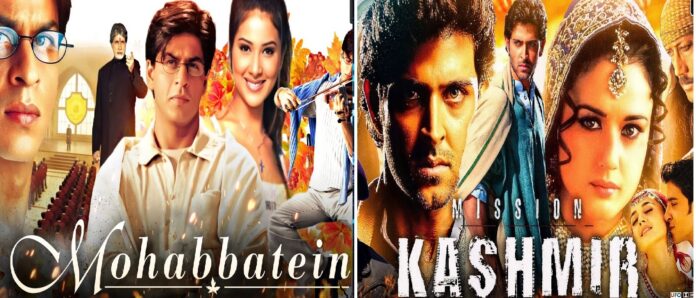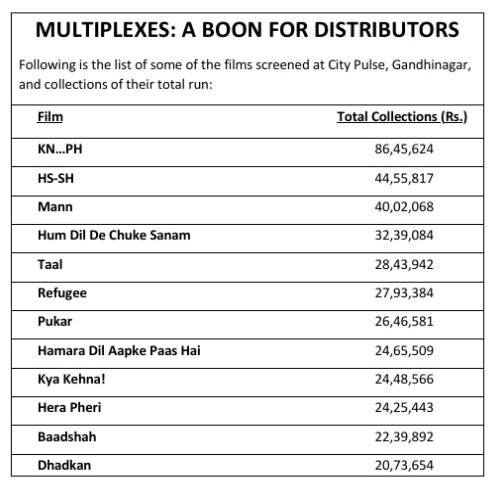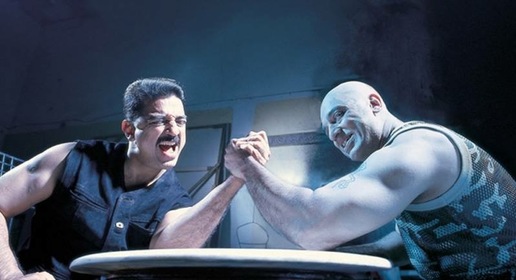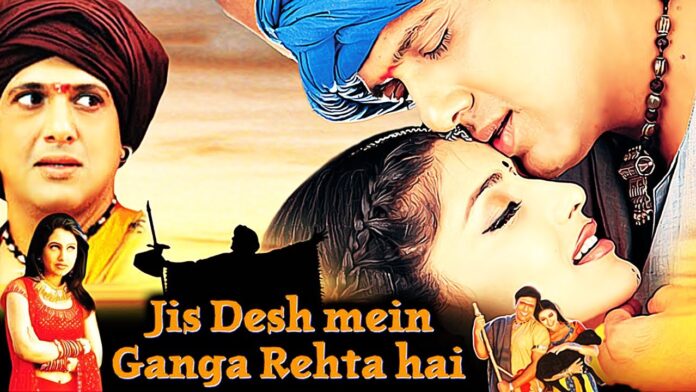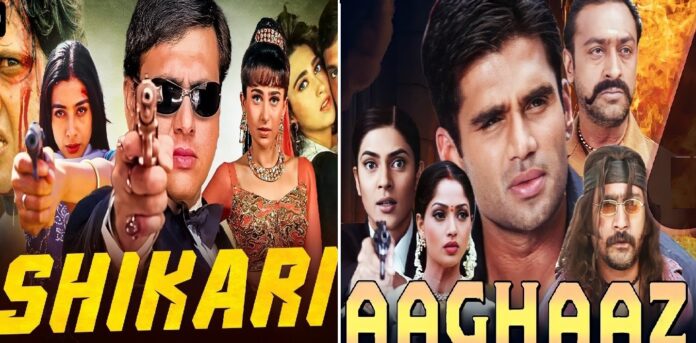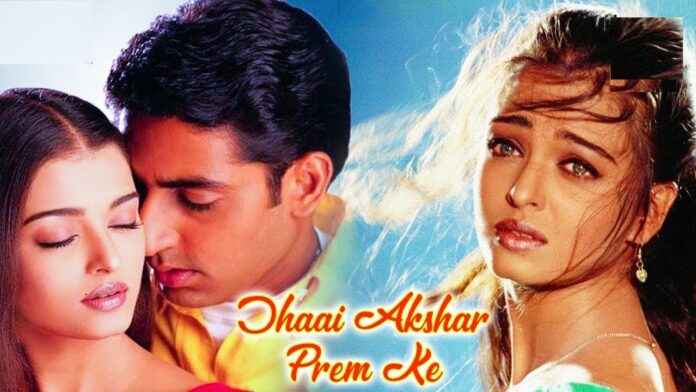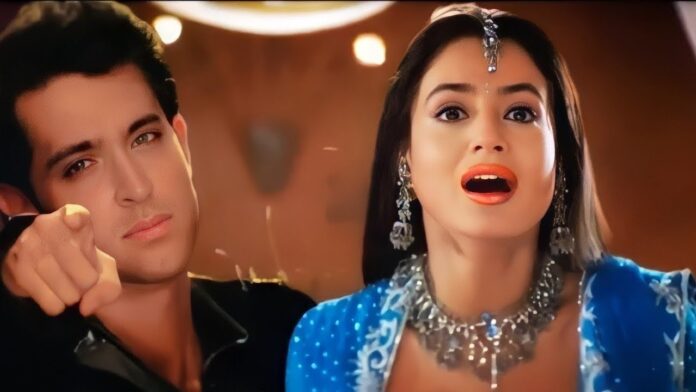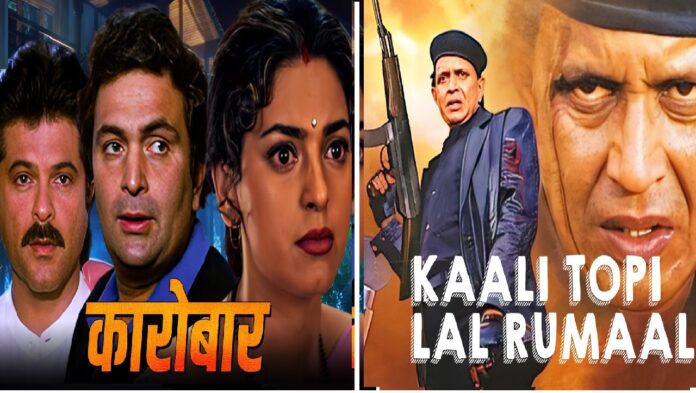KAHIN PYAAR NA HO JAAYE
Siddhivinayak Creations’ Kahin Pyaar Na Ho Jaaye (UA) is a fairly unusual story of a young guy trying to make it big in life. For a living, he sings at weddings. He loves a girl who is forced to ditch him on their marriage day, in favour of a rich NRI because she needs money for treating her kid-brother suffering from terminal cancer. The guy is shattered but soon begins to pick up the threads of his life. He falls in love with another girl who is unaware of his love for her and treats him only as a wonderful friend. By a quirk of fate, this girl, too, gets engaged to an NRI, leaving the wedding singer heartbroken once again. But this time, he tries to win his beloved back. She, too, realises that she actually loves him more than she does her fiancé. Just when the two are about to meet and express their love for each other, the singer’s earlier girlfriend emerges on the scene and complicates matters by declaring that she is still single. It also turns out that the NRI, whom she was supposed to get married to, is now the fiancé of the other girl. In a rather far-fetched and tame climax, the singer gets his second love while his first girlfriend gets the NRI’s hand in marriage.
The film has a reasonably different story but the screenplay (Sanjay Chhel and Manoj Lalwani) is poor, thanks to which the two coincidences in the singer’s life look unbelievable. Further, the dull screenplay leaves some questions unanswered. For instance, how does the singer not know till on his wedding day that the kid-brother of the girl he loves so dearly is a cancer patient? The coincidence of the same NRI being engaged to the same singer’s two girlfriends is a bit too much to digest. The scene after the first girlfriend announces to the singer her decision to marry a rich guy is quite strange. A very sensitive and serious scene appears like a mockery as the two of them laugh and cry together. Scenes showing the singer and his good-for-nothing friend drinking in the bar are very lengthy, repetitive and boring.
On the positive side, there are some scenes, emotions and directorial touches that strike a chord in the viewers’ hearts. The entire sequence of enactment of a wedding scene between the singer and his second girlfriend has been handled with great finesse. So also the scene in which the second girlfriend chides the singer for drinking himself to death and thereby mentally torturing his near and dear ones. Some comedy scenes (involving the pandit and his sons) are very enjoyable. Climax is not just weak but also childish. Overall, while the first half is quite good in parts, the post-interval portion is very weak.
Salman Khan is not consistent in his performance. While he is good in some emotional scenes, he spoils some others by his by-now-famous-and-irritating comic outbursts. In his drunken scenes, he hams, talking more like a spoilt child than a drunkard. Rani Mukerji gives a wonderful account of herself, adding the right amount of sensitiveness to her role. She is a delight to watch! Jackie Shroff acts quite well. Raveena Tandon gets limited scope but is good all the same. Pooja Batra is free and very natural. She looks pretty and impresses with her acting. Inder Kumar does a fair job. Shakti Kapoor is cute and the kids playing his four sons are even cuter. Kashmira Shah and Mohnish Bahl have their moments. Reema, Jagdeep, Sanjay Goradia, Gufi Paintal and the others lend fair support.
K. Murali Mohan Rao’s mature handling of emotional subjects is missing in this film. With a slipshod script, the director is at sea and has not been able to remain much in command. There are some scenes which impress but they are few and far between. Himesh Reshammiya’s music is melodious. The title song, ‘Anmol’, ‘Kar le pyar’ and ‘Saanwariya’ songs are very well-tuned. ‘O Priya’ has good lyrical value (Sudhakar Sharma) . Song picturisations could have been more happening. Cinematography (Rajan Kinagi) is extremely nice. Dialogues (Sanjay Chhel and Abbas Hirapurwala) are witty and humorous at places. Editing is weak.
On the whole, Kahin Pyaar Na Ho Jaaye may have some entertaining comedy but, overall, it lacks the emotions the subject needed. Even the light scenes have no hilarious moments. Lacking in all-round merits, the film will prove a burden for all concerned.
Released on 17-11-2000 at Eros and 20 other cinemas of Bombay thru Devgan Entertainment & Software Ltd. Publicity: very good. Opening: fair. …….Also released all over. Outside Bombay, the opening was weak at places and average at others.
LATEST POSITION
While KURUKSHETRA dropped as the week progressed, the topic of discussion in the trade was the drop in collections of MOHABBATEIN all over in its 3rd week.
Kurukshetra 1st week Bombay 50,00,323 (83%) from 10 cinemas (9 on F.H.); Ahmedabad 22,07,371 from 10 cinemas, Vapi 4,11,326; Pune 14,90,411 from 5 cinemas (1 in matinee), Solapur 2,96,844 (100%) from 2 cinemas (1 in matinee), Satara 2,44,791 from 2 cinemas (1 in matinee); Delhi 36,79,557 (52.96%) from 14 cinemas (3 on F.H.); Kanpur 3,54,882 from 2 cinemas, Lucknow 3,75,422, Agra 3,05,000, Varanasi 2,31,352, Allahabad 2,60,000, Bareilly 1,66,082; Calcutta 18,31,474 from 10 cinemas; Nagpur 5,52,060 from 4 cinemas, Jabalpur (6 days) 1,41,501, Amravati 3,02,204, Akola 2,17,666, Dhule (29 shows) 2,00,147 (76.68%), Bhilai 98,011, Jalgaon 2,30,005, Wardha (21 shows) 1,33,268, Chandrapur 1,73,654; Jaipur 7,36,054 (42.83%); Hyderabad (gross) 24,65,161 from 8 cinemas (2 on F.H.).
…………
Mohabbatein dropped conspicuously in its third week as schools reopened. 3rd week Bombay 62,38,903 (89.75%) from 13 cinemas (6 on F.H.), Vasai (gross) 2,84,269, Vashi (gross) 2,63,298, Panvel (28 shows, gross) 1,70,357; Ahmedabad 24,77,183 from 6 cinemas, Vapi 3,69,039 (78%), total 13,06,072, Patan (gross, 21 shows) 1,74,372 (2nd 2,59,057), Kalol (gross, 21 shows) 1,07,243 (2nd 1,90,532), Rajkot (21 shows) 2,33,500, Adipur (21 shows) 1,86,034 (69.33%); Pune 16,11,617 from 5 cinemas (1 in matinee), Solapur 2,95,883, Barsi (21 shows) 36,774, total 1,67,555, Satara 1,52,328 from 2 cinemas (1 in matinee); Delhi 51,83,331 from 12 cinemas (1 on F.H.); Kanpur 5,09,792 from 2 cinemas, Lucknow 8,94,486 from 2 cinemas, Agra 2,65,555, Varanasi 2,69,527, Allahabad 2,46,152 from 2 cinemas, Meerut 2,24,507, total 8,11,472, Bareilly (6 days) 1,69,875; Calcutta 26,13,742 from 9 cinemas; Nagpur 8,30,251 from 3 cinemas, Jabalpur (6 days) 1,88,581, Amravati 2,45,671, total 8,53,546, Akola 1,72,757, total 6,26,826, Dhule 1,32,205, total 5,78,020, Bhilai 1,80,280, Jalgaon 1,89,317, Rajnandgaon (21 shows) 68,940 (2nd 77,414), total 2,78,431, Chandrapur (21 shows) 1,38,090, total 6,34,152, Yavatmal (21 shows) 1,26,337, total 4,94,446; Indore 3,20,430 from 2 cinemas (2 on F.H.); Jaipur 4,51,017, Ajmer (28 shows) 1,35,282, Bikaner 2,14,082; Hyderabad (gross) 15,74,539 from 5 cinemas (2 in noon); 2nd week Guntur (gross) 1,37,538, total 2,92,310, Ongole (gross) 1,17,806, total 2,63,192.
Mission Kashmir crashed at several places. 3rd week Bombay 44,28,143 (63.58%) from 12 cinemas (8 on F.H.); Ahmedabad 8,31,683 from 4 cinemas, Padra 2,12,543; Pune 8,04,936 from 4 cinemas (1 in matinee), Solapur 1,40,804 from 2 cinemas (1 in matinee), Satara 71,685 from 2 cinemas (1 in matinee); Delhi 24,50,828 from 6 cinemas (3 on F.H.); Kanpur 1,51,750 from 2 cinemas, Lucknow 2,60,356, Agra 1,53,000 (2nd 2,80,000), Varanasi 1,11,341, Allahabad 1,12,000, Bareilly (6 days) 53,425; Calcutta 8,77,711 from 5 cinemas; Nagpur 1,51,783 from 2 cinemas, Jabalpur (6 days) 1,06,707, Amravati 1,03,255, Akola 71,747, total 5,17,483, Bhilai 26,938, Jalgaon 83,452, total 6,37,604, Wardha 38,529, Yavatmal (5 days) 15,860, Bilaspur 35,711, Sagar 23,630; Indore 85,000 (2 on F.H.); Jaipur 7,21,310 from 2 cinemas, Ajmer (gross, 28 shows) 1,59,660, Bikaner 1,03,556; Hyderabad (gross) 3,48,599 from 2 cinemas (1 in noon); Guntur 3 weeks’ (20 days) total (gross) 2,68,529, 2nd week Ongole (gross) 1,07,498, total 2,53,227, 1st week Nellore (gross) 1,36,410.
…………
_____
Mor Chhainha Bhuinya (Chhattisgarhi) 3rd week Raipur (nett) 2,05,482 (2nd 2,00,980), record, total for 3 weeks 6,43,796, record, 1st week Bhilai 1,54,209.
CITY GOLD MULTIPLEX OPENS IN AHMEDABAD
City Gold, one more ultra-posh and luxurious multiplex, was inaugurated in Ahmedabad on 16th November at the hands of Gujarat chief minister Keshubhai Patel. The multiplex has 5 screens although only 3 screens were thrown open to the public on 16th. The remaining two screens will open shortly.
Besides the five extraordinary screens, the complex houses an open-air theatre for cultural programmes and other functions. It has a huge car parking space in the basement.
Owned by Chimanbhai Agrawal, the cineplex has a combined seating capacity of about 1,250. It also has two restaurants and a huge foyer. The interior designing of all the screens and the entire complex has been done by City Pulse owner and leading architect Ashok Purohit.
The cinema is located on the central Ashram Road where once Dipali cinema stood. All the three screens are showing Kahin Pyaar Na Ho Jaaye this week.
Shyam Shroff, Balkrishna Shroff, Ramesh Sippy, Nandu Bohra, D.Y. Pattani, Kumar Mangat, Ashok Ahuja and Nandu Ahuja from Bombay attended the inauguration of the multiplex. (Read detailed coverage of the inauguration in our issue next week.)
DECLARED DEFAULTERS
Names of fourteen cinemas of Ahmedabad have been declared by the Ahmedabad Municipal Corporation as major defaulters of special property tax.
The dues from some of the cinemas are as follows: Shiv Rs. 39.84 lakh, Shree Rs. 60.96 lakh, Advance Rs. 18.96 lakh, Relief Rs. 17.78 lakh, Roopalee Rs. 30.27 lakh, Kamal Rs. 6 lakh, Madhuram Rs. 1.24 lakh, Priya Rs. 3.14 lakh, and Chandrabhanu Rs. 6.45 lakh.
WAHEEDA REHMAN’S HUSBAND SERIOUS
Waheeda Rehman’s husband is seriously ill in Bangalore. Waheeda was to start shooting for Karan Johar’s Kabhi Khushi Kabhie Gham this week but she could not report for the shooting due to her husband’s illness. Her role is now being played by Achala Sachdev.
BABY GIRL FOR MADHOO
Actress Madhoo gave birth to a baby girl on 16th November in Bombay.
‘MISSION KASHMIR’ TAX-FREE IN DELHI
Vidhu Vinod Chopra’s Mission Kashmir has been granted exemption from payment of entertainment tax in Delhi for a period of three months with effect from 17th November.
NEW CINEMA AT KOTPUTLI
Purva, a new cinema, opened on 17th November at Kotputli (district Jaipur) on Bansur Road. The cinema is owned by Nahatas and Swamis. Phone: (01421) 22161. Smt. Kamala, minister for irrigation & revenue, govt. of Rajasthan, was the chief guest. Hanuman Sahay Vyas, chief of the panchayat samiti of Shahpura, was a special guest.
DR. RAJKUMAR’S RELEASE:
ECSTASY AFTER 109-DAY ANXIETY!
It was freedom before sunrise for veteran Kannada films’ superstar Dr. Rajkumar when he was released at 4.30 a.m. on 15th November. The 71-year old star, who was kidnapped by Veerappan and his men on July 30, was confined to Veerappan’s jungle hideout for 109 days. The news of the superstar’s release was broken by Tamil Nadu chief minister M. Karunanidhi. Rajkumar, who went to his home town, Bangalore, soon after his release, was received by his countless admirers and fans with unprecedented jubilation. The actor underwent an ECG test and other medical tests immediately on his arrival in Bangalore. His personal physician, Dr. B. Ramana Rao, said that the veteran actor had insect bites all over his body and that he had lost weight by 4.5 kgs. “Other than that, he has no health problem,” the doctor certified.
Karnataka CM S.M. Krishna, who received the much-admired actor in Bangalore, brought him and his family members to Vidhan Soudha where Rajkumar told the press persons that his unexpected release seemed like a dream. Veerappan was led into believing that the actor could become a costly liability if held captive any longer (read details in 3-E column in this issue) and he, therefore, decided to free him. The actor also pointed out that the efforts of R.R. Gopal, editor of ‘Nakeeran’, had failed. Tamil Nadu CM M. Karunanidhi, however, acknowledged the efforts of R.R. Gopal and P. Nedumaran of Tamil National Movement for their efforts to prevail upon Veerappan to release the actor.
The question that, however, remains unanswered is: was the Rs. 50-crore ransom, demanded by Veerappan, paid to him? If not, it is unlikely that the sandalwood smuggler would have freed Rajkumar.
PRODUCTION NEWS
22-Day Shooting Spell Of ‘Nayak – The Real Hero’
A 22-day shooting stint of producer A.M. Ratnam’s Nayak – The Real Hero began on Nov. 12 in Bombay. It will be followed by shooting on locations in Pune and Madras. Many scenes and part of a song are being picturised on Anil Kapoor, Rani Mukerji, Pooja Batra, Amrish Puri, Johny Lever, Paresh Rawal, Shivaji Satam, Saurabh Shukla and Sushmita Sen (in a special appearance). Being directed by Shankar, the film has music by A.R. Rahman. Lyrics: Anand Bakshi. Dialogues: Anurag Kashyap. Cinematographer: K.V. Anand. Art: Thotta Tharani. Action: Kunal Kannan. Editors: B. Lenin and V.T. Vijayan.
‘Mujhe Kuch Kehna Hai’ In Delhi
Puja Films’ Mujhe Kuch Kehna Hai is being shot in a 15-day schedule from Nov. 17 in Delhi. Being produced by Vashu Bhagnani and directed by Satish Kaushik, the film stars Tusshar and Kareena Kapoor with Amrish Puri, Dalip Tahhil, Himani Shivpuri, Alok Nath, Pankaj Berry, Vrajesh Hirjee, Hemant Pande, Punit, Rashmi and Rinke Khanna. Music: Anu Malik. Lyrics: Sameer. Cinematography: Johny Lal. Art: Sameer Chanda. Action: Mahendra Verma. Sound: Jagmohan Anand.
3-E
Education-Entertainment-Enlightenment
Salman Khan: Waning Popularity?
Is Salman’s popularity on the wane? Or is it the lack of publicity as compared to other recent Salman starrers, which is responsible for a dull opening of Kahin Pyaar Na Ho Jaaye this week? It is a combination of both.
Salman’s career has been on the downslide for almost two years now. Several of his starrers have been bombing at the box-office. Jaanam Samjha Karo flopped in April 1999, followed by Hello Brother. Chal Mere Bhai just didn’t work. Dulhan Hum Le Jayenge barely managed to scrape through in some territories. Har Dil Jo Pyar Karega took a flying start, but that was about the only silver lining to the film’s overall box-office performance.
This week’s Kahin Pyaar Na Ho Jaaye has opened to ordinary houses in Bombay but even less-than-ordinary houses in cities like Delhi, Jaipur etc. and towns like Khandwa (C.P. Berar).
This is a clear indication that Salman’s fan-following has considerably reduced in sheer numbers. For every shirt that Salman takes off in a film, he may be losing around a lakh fans, going by the rapid rate at which his films are failing. His senseless antics on the screen and his receding hairline are also contributing to this otherwise handsome hero’s declining popularity. Besides, Salman’s penchant for doing the nonsensical before the cameras has got on people’s nerves now.
In the case of KPNHJ, the lack of time given for its music to grow has also gone against the film’s opening. For, despite the presence of some exciting numbers in the film’s album, they haven’t really floored the listeners.
Whatever the reasons, the dull initial of Kahin Pyaar Na Ho Jaaye is a danger signal for Salman. For, there’s no problem as long as he loses his shirt in film after film. But losing in popularity is a big worry. After all, box-office figures lay everything threadbare and conceal nothing. Rather, they reveal the naked truth.
Ramraj-ji’s Judgement Extraordinaire
A reading of this week’s Flashback column (page 14 of this issue) made the senior family members of Film Information go nostalgic. The then owner-editor-printer-publisher, Shri Ramraj Nahta, had predicted not even 15 weeks after Sholay was released: ‘Sholay has beaten by lengths super-hit films like Bobby and Roti Kapada Aur Makaan at most of the places; it may draw full houses for 50 weeks at local Minerva.’ Today, after Sholay has been acknowledged as a landmark film of Indian cinema, this statement may not look very bold. But to have predicted then that the film would draw full houses for 50 weeks together required not just guts but tremendous foresight, both of which Ramraj-ji possessed in ample measure. Guts, because there were many, many in the trade who dogmatically maintained that Sholay was no big hit and that its glory would be short-lived. They maintained that the effervescence of the initial euphoria would die down soon. Among such pessimists was a trade paper, too, which revelled in calling Sholay a weak film for weeks together. Ultimately, of course, those people as well as the trade paper had to bite the dust. As for your editor then, this prediction more than proved right! For, Sholay ran to full houses at Bombay’s Minerva cinema not just for 50 weeks but for 265 weeks!! Ramraj-ji’s prediction, like his review of Sholay in Film Information, published a day after its release, drew a lot of flak in the beginning, but ultimately proved yet another feather in his cap for his superb judgement.
No Name Is A Good Name!
Boney and Sridevi Kapoor are still without a name for their new-born. Two weeks after her birth, the second daughter of the producer-actress couple is nameless. That’s because the li’l one’s parents can’t agree on any name.
While Khushi appeals to Boney, Sridevi finds it too filmy. “She takes a little long to appreciate good things,” jokes Boney, but Sridevi is not in a mood to give in.
And so the search for an appropriate name for Janhvi’s little sister goes on.
Incidentally, Janhvi was Urmila Matondkar’s name is Boney’s Judaai. Janhvi was born a few days before the release of Judaai. Khushi is Sonali Bendre’s name in Boney’s Hamara Dil Aapke Paas Hai which was released about three months back. So Sri is not wrong when she says, “Khushi is too filmi.”






























